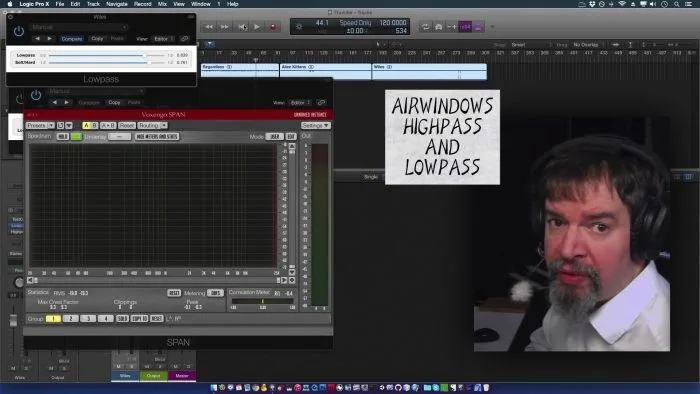Airwindows has launched some more free effect plugins for Windows, ported from previously released Mac Audio Units formats. The ToneSlant plugin is a completely new.
Density offers smooth saturation or antisaturation.
This one started a lot! The algorithm used here has echoed through many other Airwindows plugins. It’s literally the smoothest saturation you can have in a plugin: the transfer function’s a sine. This is what’s in Channel, too: there are many ways to adapt such a simple mathematical function.
But there’s more! Because Density runs multiple stages, allowing it to bulk up the tone into an overblown, insanely fat and saturated distort-fest. And then you can highpass just the distorted stuff alone, and trim its output gain, and mix it with the unfiltered dry to produce lots of tonal possibilities. And then there’s the spatial positioning factor: saturating stuff this way brings it forward in the mix. You can also isolate midrangey elements and bring them forward using that trick.
And then there’s the negative values: if you UNsaturate, you get a thinned out lean tone and it drops back instead of pushing forward. And you can blend that too.
Lowpass and Highpass are two mixing EQs.
They’re complementary: the one is the inverse of the other. However, because of their peculiarities that makes them behave quite differently. What they have in common is they’re interleaved IIR filters, something people don’t normally do. The experiment here has to do with my discovery that digital audio only exists in sets of samples (never just as the isolated sample: the waveform isn’t there, the sample value is only a signpost that the audio is to weave its way around)
They’ve also got a very unusual parameter, soft/hard or loose/tight, which controls how the IIR filters are fed audio. When you offset it, you get a situation where the cutoff is higher at louder volumes, or at quieter volumes. This is on a sample-by-sample basis so it’s a tone-character modification, subtle but interesting. Loose/tight is just the best way I could describe what’s happening there.
ToneSlant is a completely new plugin (not a port from an exiting Audion Unit), based on a variation on the Average concept.
Turns out, it’s the tail end of the ‘averaged samples block’ that causes the cancellation node. ToneSlant implements a much bigger sample block (100 taps) but linearly fades the samples off between the first and last sample in the block.
What that does, is produce an extremely transparent ’tilt EQ’ with a controllable corner point. And, it’s implemented in such a way that you can set it to null out (at extreme high boosts) and then bring in only the brightest highs (shown in the video). Quirky, maybe, but it broadens the ToneSlant toolkit.
Average offers a lowpass filter with a distinctive tone.
There’s a reason you don’t see this filter used for lowpasses: it’s not technically correct. In fact it whacks a great big cancellation node into the high frequencies, and the tone (while pleasing) is very obviously affected by this. It’s a bit of a flangey quality.
BUT, we know better than to be limited by technical concepts, right? After all, the classic Scream Tracker resonant lowpass is known to be broken, and that has a real character to it. And even the Roland Supersaw is known to have some quirks that make it what it is…
Average has a fantastic tonality once you accept the response quirks. You can dial in the notches to suppress unwanted content, and (in a post-video revision) it’s got a dry-wet control so you can moderate the effect—and, typically for Airwindows, if this dry/wet is set to full wet, the calculations for doing that drop out of the plugin entirely so you’re not doing an unnecessary multiply.
The Airwindows plugins are a free download for Windows and Mac (VST/AU). You can support Chris for his efforts at Patreon.
More information: Airwindows
 Save up to 95% in Plugin Boutique's Spring Sale!
Save up to 95% in Plugin Boutique's Spring Sale!

